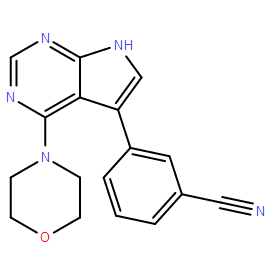| Cas No.: | 1527473-33-1 |
| Chemical Name: | 3-[4-(4-Morpholinyl)-7H-pyrrolo[2,3-d]pyrimidin-5-yl]-benzonitrile |
| Synonyms: | PF 06447475,PF06447475 |
| SMILES: | C1COCCN1C2=NC=NC3=C2C(=CN3)C4=CC=CC(=C4)C#N |
| Formula: | C17H15N5O |
| M.Wt: | 305.33 |
| Purity: | >98% |
| Sotrage: | 2 years -20°C Powder, 2 weeks 4°C in DMSO, 6 months -80°C in DMSO |
| Description: | PF-06447475 is a highly potent, selective and brain penetrant LRRK2 inhibitor with an IC50 of 3 nM. |
| Target: | IC50: 3 nM (LRRK2)[1]. |
| In Vivo: | In G2019S+ rats treated with PF-06447475, a significant reduction in microgliosis to levels found in wild-type rats could be observed. The proinflammatory marker MHC-II expressed on myeloid cells but not neurons also appears to be less abundant in confocal sections in G2019S+ rats treated with PF-06447475. PF-06447475 treatment in G2019S+ rats significantly lowers the number of CD68 cells recruited to the SNpc. PF-06447475 successfully blocks the enhanced neuroinflammation associated with G2019S-LRRK2 expression. Treatment of G2019S+ rats with PF-06447475 preserves TH expression in the dorsal striatum, consistent with drug attenuating neurodegeneration in the SNpc[3]. PF-06447475 is well tolerated in rats[1]. |
| In Vitro: | PF-06447475 inhibits LRRK2 enzyme and LRRK2 in the whole cell assay with IC50s of 3 and 25 nM, respectively[1]. Cells incubated with PF-06447475 alone (0.5, 1, 3 μM) or in the presence of ROT significantly reduces (S935)-LRRK2 kinase phosphorylation to control. PF-06447475 significantly preserves the nucleus morphology and ΔΨm of NLCs exposed to ROT compared to untreated and control. PF-475 significantly diminishes ROT-induced ROS generation to a similar extent to cells exposed to PF-475 alone[2]. |
| Animal Administration: | Rats: PF-06447475 are administered to the desired amount in a suspension solution consisting of 10% propylene glycol, 20% PEG-400, and 70% 0.5% methylcellulose. To determine the potency of PF-06447475 in blocking brain LRRK2 kinase activity, wild-type Sprague-Dawley rats are treated at 3 and 30 mg/kg PF-06447475 (p.o. b.i.d.) for 14 days, and total and phospho-LRRK2 are subsequently measured from brain tissue lysates[3]. |
| References: | [1]. Henderson JL, et al. Discovery and preclinical profiling of 3-[4-(morpholin-4-yl)-7H-pyrrolo[2,3-d]pyrimidin-5-yl]benzonitrile (PF-06447475), a highly potent, selective, brain penetrant, and in vivo active LRRK2 kinase inhibitor. J Med Chem. 2015 Jan 8;58(1):419-32. [2]. Mendivil-Perez M, et al. Neuroprotective Effect of the LRRK2 Kinase Inhibitor PF-06447475 in Human Nerve-Like Differentiated Cells Exposed to Oxidative Stress Stimuli: Implications for Parkinson's Disease. Neurochem Res. 2016 Oct;41(10):2675-2692. [3]. Daher JP, et al. Leucine-rich Repeat Kinase 2 (LRRK2) Pharmacological Inhibition Abates α-Synuclein Gene-induced Neurodegeneration. J Biol Chem. 2015 Aug 7;290(32):19433-44. |

 DC Chemicals' products qualify for U.S. tariff exemptions. We guarantee no price increases due to customs duties and maintain stable supply, continuing to deliver reliable research solutions to our American clients.
DC Chemicals' products qualify for U.S. tariff exemptions. We guarantee no price increases due to customs duties and maintain stable supply, continuing to deliver reliable research solutions to our American clients.





















